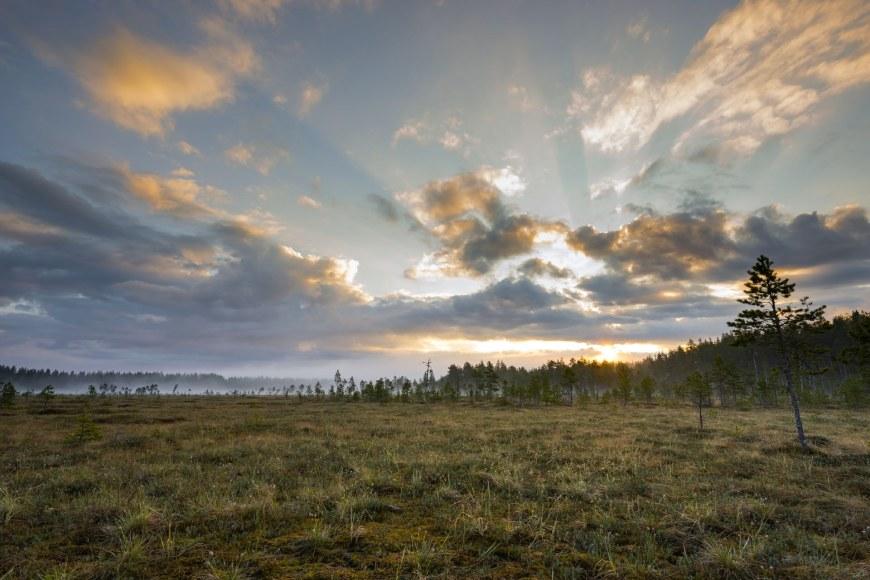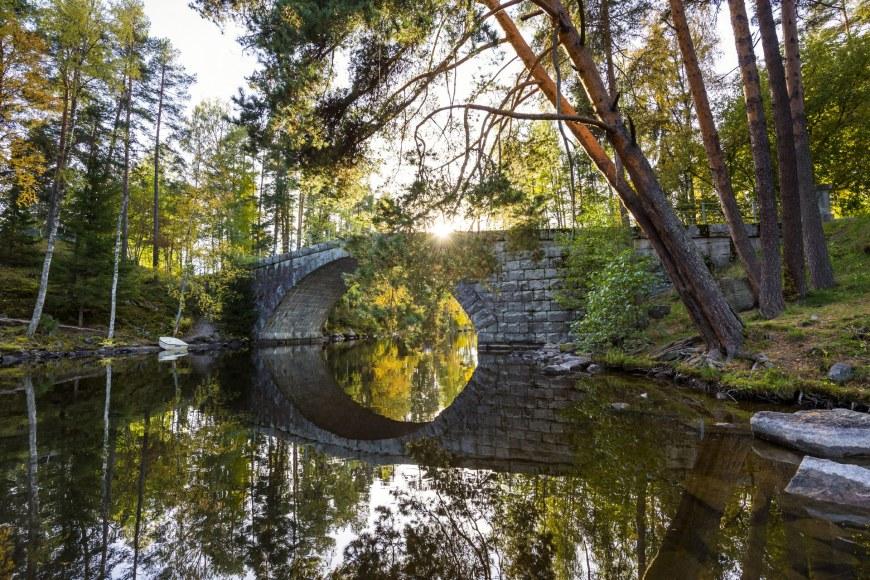Nurtured by virtual nature

This article was originally published in Unit, the magazine of Tampere Universities.
Research has shown that exposure to nature has a positive effect on human health. Interacting with nature makes us feel better, helps us to recover from stress and delivers a range of measurable physiological benefits: a walk in the woods reduces our blood pressure and heart rate.
Even virtual experiences of the natural world – such as watching nature videos and listening to nature sounds – have a similar effect. Studies carried out at the Natural Resources Institute Finland (LUKE) demonstrate that it takes as little as 15 minutes in a virtual nature setting to reduce stress.
But what exactly is virtual nature?
According to Tomi Nukarinen, postdoctoral research fellow at Tampere University whose research combines psychology and interactive technology, the concept of virtual nature is broad and complex.
“Virtual nature is an immersive, computer-generated environment that is created to simulate nature and achieve a specific purpose,” he says.
Juho Hamari, professor of gamification at Tampere University, defines virtual nature as practically any simulated natural environment that is experienced through one or multiple senses.
Developing multimodal virtual reality experiences
When researchers at LUKE examined the invigorating effects of virtual nature a few years ago, the research setting was simple: the participants watched nature videos in a quiet room. Virtual nature can also be a multimodal experience that involves multiple senses and is created with the help of virtual reality (VR) goggles or a dedicated VR space.
Hamari says the multimodal approach is also gaining ground in the gaming industry.
“The main challenge facing researchers is mimicking the rich, multisensory and multimodal experience of being in nature.”
Would it be possible to incorporate, for example, the health benefits of warmth or the ability of UV light to stimulate the production of vitamin D in the skin into a virtual environment?
Tomi Nukarinen is, in particular, interested in exploring how smell, touch and lighting effects could be integrated into VR.
“Would it be possible to incorporate, for example, the health benefits of warmth or the ability of UV light to stimulate the production of vitamin D in the skin into a virtual environment?” he muses.
The sense of hearing could also be increasingly engaged to deepen the sense of immersion, he finds.
“Research on the role of auditory stimuli in virtual nature is still in its infancy because there has been such a strong focus on visual content.”
UNITE brings interactive game elements into the woods
As securing funding for research on virtual nature has been difficult in Finland, there has been limited research on the topic. All this changed in late 2020, when the Academy of Finland granted more than €10 million for the UNITE flagship project, which is seeking to diversify forest-based livelihoods by integrating game elements into the interactions between nature, people and machines.
UNITE is coordinated by the University of Eastern Finland and involves Tampere University, the National Land Survey of Finland and several partner companies. Researchers at LUKE, who have previously studied the restorative benefits of virtual nature, will also participate in the project.

Juho Hamari coordinates the subproject carried out at Tampere University. He says the primary goal of the UNITE project is to discover new ways of collecting, interpreting and utilising information about the natural world and thereby strengthen the multifaceted relationship between people and ecosystems.
“In this area, the strength of researchers at Tampere University lies in human-machine interaction. The range of gamification applications includes, for example, location-based games, drone racing, wearable technologies with built-in game elements, simulations, game-based decision-making systems, VR technologies and augmented reality (AR) technologies.”
Hamari points out that the project will develop not only the technology for delivering virtual nature experiences but also the digital methods for collecting forest data.
“UNITE brings together the expertise of the game industry and the forest industry. Rather than focus solely on the health benefits of nature, we will also develop technology that will provide forest owners with access to data to support informed decision-making.”
Indicators for measuring the effects of virtual nature
Tomi Nukarinen is also launching an Academy of Finland-funded study on virtual nature. He has set his sights on developing concrete indicators for measuring the restorative effects of virtual nature. His intention is to set up an experimental VR space at Tampere University that will bring the sense of smell and the sensation of warmth to the VR world in addition to the more standard audio-visual content.
“The goal is to add meditation exercises to the experiments to increase the restorative effects of the VR experience,” Nukarinen says.
The physiological, cognitive and emotional effects of virtual nature will be measured on the research participants. Social and ecological variables will also be examined, such as the association between virtual nature experiences and empathy and connectedness to nature. Similar measurements have not been attempted before on this scale.
Virtual nature opens up a broad range of applications that go beyond healthcare and well-being services.
Nukarinen adds that the restorative effects of nature could be virtually enjoyed, for example, in staff break rooms, nursing homes, hospitals, prisons – places where it is difficult to reach green spaces. Dental clinics, therapist offices and different learning environments would also provide an ideal setting for enjoying the soothing effect of nature.
Finland well positioned to lead the way in developing virtual nature
Although virtual nature experiences have been relatively little studied globally, Nukarinen has found some collaboration partners from universities in the USA, UK, Germany and Norway. However, the topic is attracting growing scientific interest.
“The field is still young. VR goggles that are capable of delivering a virtual nature experience only became commercially available about five years ago,” Nukarinen points out.
Juho Hamari estimates that Finland is well positioned to lead the way in developing virtual nature technologies and apps.
“We already have quite a few of the necessary elements: nature, technological expertise and research on multimodal equipment. In addition, Finland’s forest industry and game industry are thriving.”
Tomi Nukarinen highlights the fact that virtual nature opens up a broad range of applications that go beyond healthcare and well-being services.
“Virtual nature has applications in architecture, forest management and environmental management, among other things. It also offers new opportunities for artists. For example, a piece of performance art where the audience wore a VR headset to discover how frogs see the world took place in Nuuksio National Park in the south of Finland a couple of years ago.”
Virtual nature will also open up a new world of possibilities for the game industry. As Juho Hamari says, both virtual nature and the game industry employ the same technologies, such as 3D game engines.
“Location-based games have tended to take place in urban settings, but I am sure the game industry will be interested in taking players into nature, too. As virtual nature applications become more sophisticated, we are also bound to see more multisensory elements in video games,” he notes.
The travel industry is a sector where virtual nature has already been utilised for business purposes. For example, a company called saimaaLife developed a virtual nature tour concept a few years back and during the Covid-19 pandemic offered virtual escapes that took visitors around the beautiful landscape in the south-eastern part of Finland.

Virtual technology makes inroads into the travel industry
Virtual reality enables people to transcend the laws of physics.
One day while sitting on a bus, Vesa Vuorinen, senior lecturer at Tampere University of Applied Sciences, got to thinking about Hayday, the mobile farming game developed by Supercell. Wouldn’t it be fun if the farm really existed? Players could buy a real carrot for a real donkey, take part in purchasing a tractor, or even visit the farm to buy milk.
The seeds had been sown for a new research project.
Now Tampere University of Applied Sciences is coordinating the Virtual Travel (VIRMA) project. The project helps travel companies, which have been hard hit by the Covid-19 pandemic, to find new business opportunities and customers with the help of VR. The project will also explore new perspectives on travel.
“We are looking to go beyond the ordinary. Instead of trying to figure out how to go skiing in a virtual world, we will, for example, invite students attending an innovation course to brainstorm and come up with unique VR-based business ideas,” Vuorinen says.
Companies are also providing other input and practical tips. For example, one of the partner companies, Saunakonkeli, has shared information about offering virtual sauna experiences to customers in Japan.
“All travel companies that have been invited to join the innovation activities have jumped at the chance. Given that we are able to provide the companies with concrete benefits, launching the collaboration has been easy.”
Technology enables and constraints
Virtual technology enables experiences that break the laws of physics and could not take place in the real world, such as the ultimate science fiction experience: immortality.
“Many people are eager to leave a lasting legacy. It would be intriguing if we could create a hologram based on an actual person’s voice, gestures and appearance. With the help of artificial intelligence, this hologram could converse with his relatives in the year 2200 and talk about what life was like during our time. Or people could look back at their younger self in the form of a hologram,” Vuorinen envisions.
Virtual travel is like a teaser that gives a sneak peek into your destination.
Taking a trip with a real historical figure would be equally intriguing. For example, Julius Caesar could serve as a guide, and we could take part in his battles.
In these time travel scenarios, virtual travel is very much a gamified experience.
“I would be keen to travel back in time to 1918, the year of the Finnish Civil War. I would like to talk with the people and try to understand the reasons for the war. In fact, this can already be achieved with current VR technology.”
What currently limits the immersiveness of virtual travel is that VR headsets are not yet widely available. The experience is very much focused on sight and hearing, and the platform is typically a mobile device or a computer.
“The sensory experience could potentially be expanded, so that travellers can feel it when they enter, for example, a sauna and have a cooling drink.”
Of course, virtual travel cannot replace the real thing. And nor should it, says Vuorinen.
“Virtual travel is like a teaser that gives a sneak peek into your destination or allows you to reminisce your past journeys, so it could replace photographs.”
Rethinking the earnings logic
Vuorinen is hoping to see the travel industry tap into the full potential of augmented reality to add value to their services. The earnings logic will need to be completely rethought as well.
“Watching videos on YouTube has become a hugely popular pastime. The next step in the vlogging phenomenon would be that instead of supporting a specific channel, viewers could take part in and support the activity on the channel, such as buy a carrot for a donkey on a farm.”
If Vuorinen could travel through time into the not-too-distant future when the VIRMA project ends, what would he hope to see?
“I want to help these companies, and my sympathies are fully on their side. Covid-19 has suddenly pulled the rug out from under the travel industry. If after the project even a single company thanks us and thinks we have been able to help, we will have succeeded.”
The VIRMA project
- The project involves Visit Tampere and several local travel and virtual technology companies.
- The project is funded by the European Regional Development Fund.
- The project runs from 1 April 2021 to 31 March 2023.
Author: Minna Nurro, Sari Laapotti







